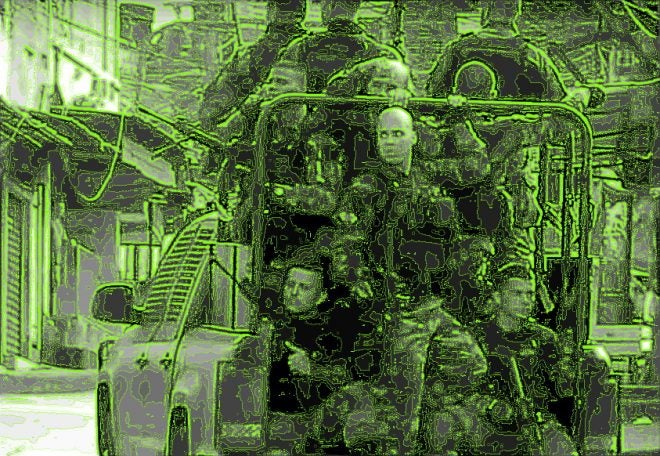The non-stop drug war taking place in Brazil’s most famous city during the last years has usually brought firearms to the attention of the general public and, much more so, to that of the TFB-type readership. As it happens when the going gets tougher than it usually is, the Armed Forces are often called in to give local LE agencies a helping hand. It should be pointed out that the military is mainly used as a support force generally in charge of providing perimeter establishment and tight security check points, while Military and Civil Police elements carry out the actual burden of entering deeper into conflict zones they are much more familiar with. The rationale is that this will make a larger number of police agents available for ‘frontline’ combat in areas under heavier external control by the military. This scribe would definitely like to see military (Army, Marine Corps, and Air Force) Spec Ops troops, highly capable of doing so, fully committed to the actual combat part involved in such internal security operations, but, somehow, this is still generally avoided by some politically-minded authorities. Since this is a “firearms not politics” blog, I will refrain from further discussing this part of the strategy at hand.
The month of September witnessed a particularly active period of LE and military operations in Rio de Janeiro, most of them triggered by gang-against-gang conflicts for the control of drug trafficking in different areas, such as Rocinha, a huge South Zone community where over 70,000 people live on mostly hillside areas with very narrow streets and a multitude of even narrower pathways which constitute a tactical planning nightmare. What follows is a small selection of pictures (courtesy of Oyoy Kanamox) obtained in different parts of the city during the period mentioned above.
Higher-res pics? Here: https://imgur.com/a/aSgWL
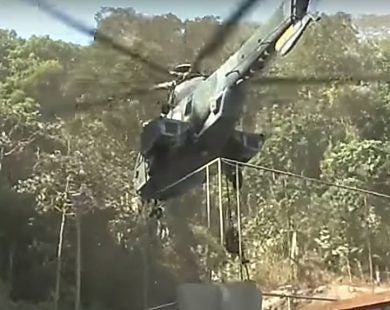
At an early part of the Rocinha community operations, an Air Force H-36 Caracal (H225M) helicopter was used for a fast-rope insertion of Army SpecOps troops at a tight, higher-ground spot.

Those who descended from the chopper were carrying weapons whose existence in Brazilian Army hands were hardly known. This included a 7.62x51mm Heckler & Koch HK417, the shorter-barrel (13”) variant, seen here fitted with a bipod and what appears to be an ELCAN Specter scope, plus a (Steiner?) laser sight.


With the same group of soldiers were these 7.62x51mm KAC M110 SASS (Semi-Automatic Sniper System) rifles.
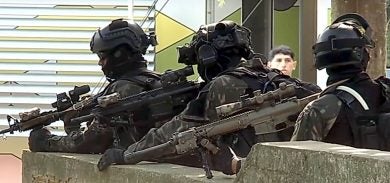
The M110 SASS and the HK417 are seen here together with a 5.56x45mm M4-type carbine of unidentified origin, but fully-fitted with sighting stuff.

In sharp technological contrast, this officer is carrying his old, but still trusty, Madsen M1931 light machine gun, which remains in the inventory of Polícia Militar do Estado do Rio de Janeiro. Originally in the 7x57mm Mauser caliber, they were modified to 7.62x51mm by IMBEL’s Fábrica de Itajubá in the 1980s.

This female PMERJ soldier is holding a .40 S&W Taurus CTT40 carbine. The weapon is generally issued to troops serving in the so-called UPPs – Unidades de Polícia Pacificadora (Pacifying Police Units), such as the one in the Rocinha community.
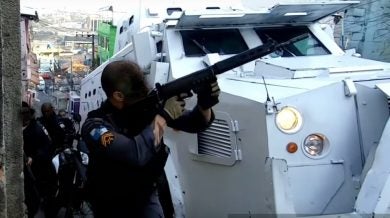
Curiously enough, some Military Police armored vehicles assigned to the UPP units are now painted in white rather than the all-black “Caveirões” (“Big Skulls”) traditionally used by other PMERJ battalions. Corporal in the foreground is armed with a short (440mm) barrel IMBEL PARA-FAL.
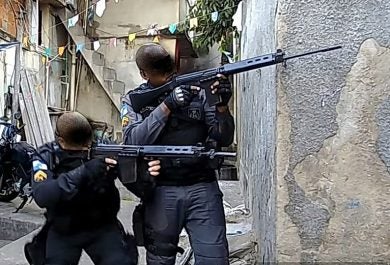
The M964 FAL (533mm barrel) and the M964A1 PARA-FAL (440mm barrel) are in widespread use by all PMERJ standard battalions. Operator of the latter has added a vertical fore grip to his gun.
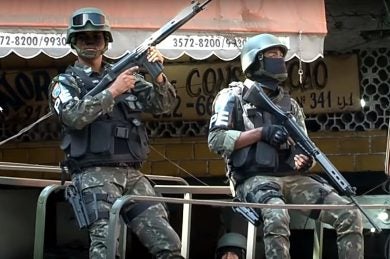
Standard, fixed-stock FALs in the hands of PE (Polícia do Exército, Army Police) troops. The 7.62x51mm rifle is still the main type in Brazilian Army use.
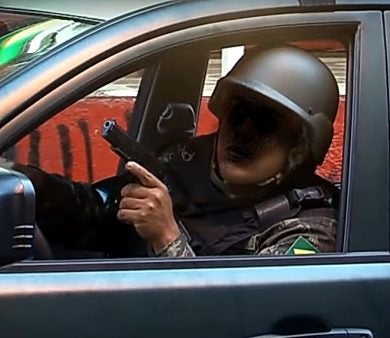
Seen here in the hand of an Army PE vehicle driver, the 9x19mm IMBEL M973 is an M1911A1 derivative which is, to all extents and purposes, the official Brazilian Army pistol.
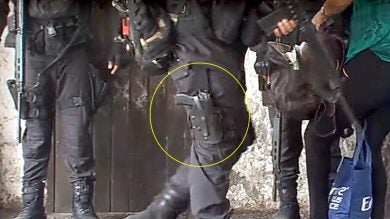
For the police forces, however, the use of handguns is far from standardized. The leg-holstered pistol shown here with a PMERJ agent is a .40 S&W Taurus PT840.
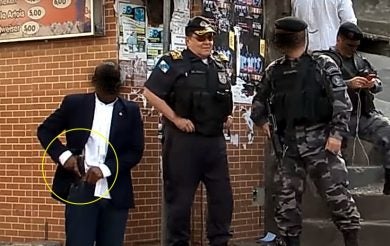
The 9x19mm Glock 17 has been in use by some PMERJ specialized units for some time, including by the bodyguards of the agency’s General Commander, Col. Wolney Dias.

The same member of Col. Dias’ security detail is seen here carrying a 7.62x51mm Armalite AR-10A4 rifle during the recent operations in the Rocinha community.
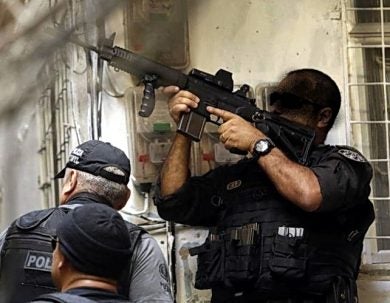
Another AR-10A4 in action, this time in the hands of PCERJ – Polícia Civil do Estado do Rio de Janeiro (Civil Police). The operator belongs to the crack CORE – Coordenadoria de Recursos Especiais, the SpecOps unit. EOTech sights and foldable fore grips came with all Armalite-supplied guns
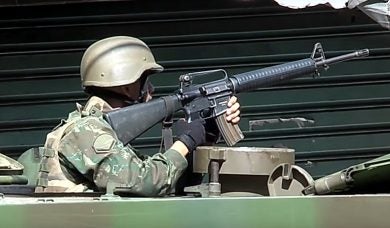
This Brazilian Marine Corps trooper is carrying the standard-issue 5.56x45mm Colt M16A2 while riding a Mowag Piranha 8×8 armored personal carrier.
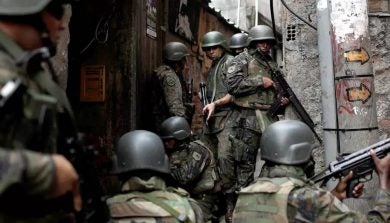
Brazilian Air Force troops are still basically equipped with 5.56x45mm Heckler & Kock HK33 rifles acquired in the early 1970s, the retractable-stock model seen here. The urban combat scenarios in some of Rio’s communities are hair-raising as far as narrow streets/pathways are concerned. Armed criminals may pop out at any time!
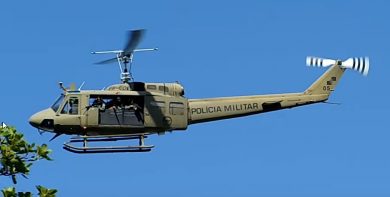
A UH-1H Huey II flying top cover for ground troops, crew members behind the armored side panels being armed with AR-10A4s. Chopper is operated by PMERJ’s GAM – Grupamento Aeromóvel (Airmobile Group).
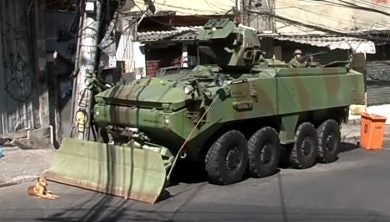
This Marine Corps Piranha Armored Personnel Carrier is fitted with a dozer blade for eventual removal of obstacles erected by criminals. No, sir, the civilian K9 was just watching the troops…
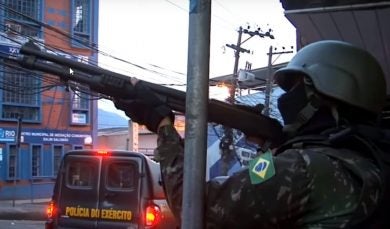
A Polícia do Exército (Army Police) trooper taking a fire position with a 12ga Mossberg M590A1 shotgun.
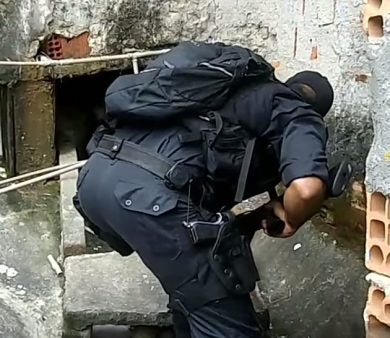
While searching a decrepit building with a solid-stock FAL in his hands, this PMERJ soldier is also carrying a holstered .40 S&W Taurus PT100. Other issued pistols of Rio’s Military Police include the IMBEL-made MD5 and MD5 LX.

These Marine Corps COMANFs (Amphibious Commandos) are using 5.56x45mm Heckler & Koch HK416 rifles, the shorter model with an 11” barrel, vertical fore grip, holographic sight, tactical light, et al. Skull face masks and balaclavas eventually worn during the recent operations were criticized by some local politically-correct medias as being… “too scary” for children! O.M.G.!
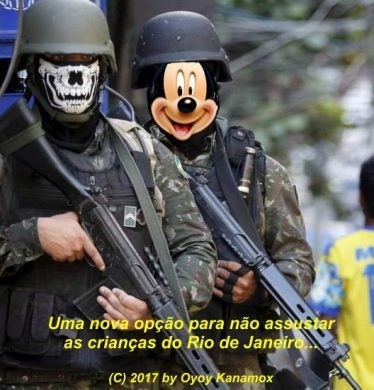
In order to avoid eventual traumatic, visual experiences for kids watching the troops on patrol, the photo above has circulated in the social media to suggest a “Plan B” for the military who must wear identity-covering items. Not because they may do something wrong while on duty, but simply because many of the troops live in criminal-infested areas and fear to be recognized as LE/military agents when they go back home: a basic measure to survive in this hot spot of the globe. Simple as that!
 Your Privacy Choices
Your Privacy Choices
